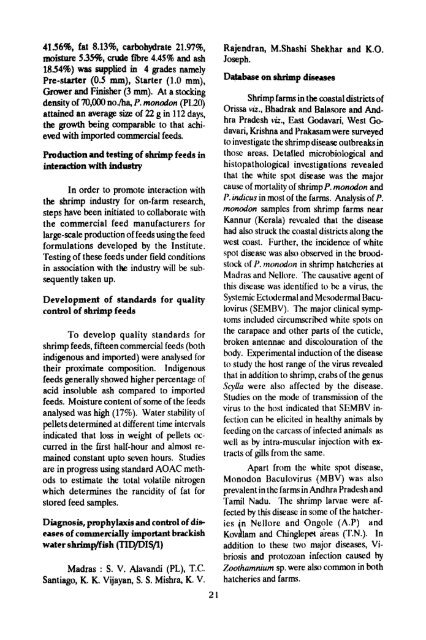annual report - Central Institute of Brackishwater Aquaculture
annual report - Central Institute of Brackishwater Aquaculture
annual report - Central Institute of Brackishwater Aquaculture
Create successful ePaper yourself
Turn your PDF publications into a flip-book with our unique Google optimized e-Paper software.
41.5696, fat 8.13% carbohydrate 21.9746,<br />
moisture 53%, crude fibre 4.46% and ash<br />
1854%) was supplied in 4 grades namely<br />
Pre-starter (0.5 mm), Starter (1.0 mm),<br />
Grower and Finisher (3 mm). At a stocking<br />
density <strong>of</strong> 70,000 noha, P. monodon (PL20)<br />
attained an average size <strong>of</strong> 22 g in 112 days,<br />
the growth being comparable to that achieved<br />
with imported mmmercial feeds.<br />
Production and testing <strong>of</strong> shrimp feeds in<br />
interaction with industry<br />
In order to promote interaction with<br />
the shrimp industry for on-farm research,<br />
steps have been initiated to collaborate with<br />
the commercial feed manufacturers for<br />
large-scale production <strong>of</strong> feeds wing the feed<br />
formulations developed by the <strong>Institute</strong>.<br />
'Testing <strong>of</strong> these feeds under field conditions<br />
in association with the industry will be subsequently<br />
taken up.<br />
Development <strong>of</strong> standards for quality<br />
control <strong>of</strong> shrimp feeds<br />
To develop quality standards for<br />
shrimp feeds, fifteen commercial feeds (both<br />
indigenous and imported) were ana1yst.d for<br />
their proximate composition. Indigenous<br />
feeds generally showed higher percentag ol<br />
acid insoluble ash compared to imp~rted<br />
feeds. Moisture content <strong>of</strong> some <strong>of</strong> the feeds<br />
analy.sed was high (17%). Water stability <strong>of</strong><br />
pellets determined at different time intervals<br />
indicated that loss in weight <strong>of</strong> pellets occurred<br />
in the first half-hour and almost remained<br />
constant upto seven hours. Studies<br />
are in progress using standard AOAC methods<br />
to estimate the total volatile nitrogen<br />
which determines the rancidity <strong>of</strong> fat for<br />
stored feed samples.<br />
Diagnosis, prophylaxis and control <strong>of</strong> die<br />
eases <strong>of</strong> commexcially impottant brackish<br />
water shrimp/fish (TIDPISP)<br />
Madras : S. V. Alavandi (PL), T.C.<br />
Santiago, K. K. Vijayan, S. S. Mishra, K. V.<br />
Rajendran, M.Shashi Shekhar and K.O.<br />
Joseph.<br />
Shrimp farms in the coastal districts <strong>of</strong><br />
Orissa vu., Bhadrak and Balasnre and Andhra<br />
Pradesh vu., East Godavari, West Godavari,<br />
Krishna and Prakasam were surveyed<br />
to investigate the shrimpdisease outbreaksin<br />
those areas. Detalled microbiological and<br />
histopathological investigations revealed<br />
that the white spot disease was the major<br />
cause <strong>of</strong> mortality <strong>of</strong> shrimpP. monodon and<br />
1'. indrcus in most <strong>of</strong> the farms. Analysis <strong>of</strong> P.<br />
rnonodon samples from shrimp farms near<br />
Kannur (Kerala) revealed that the disease<br />
had also struck the coastal districts along the<br />
west coast. Further, the incidence <strong>of</strong> white<br />
spot disease was also ~hserved in the brtx>dstock<br />
ol IJ. rnutzdon in shrimp hatchcries at<br />
Madras and Nellore. 'The causative agent <strong>of</strong><br />
this disease was idcntificd to hc a virus, the<br />
Systemic Eetodermal and Mesodermal Uaculovirus<br />
(SEMRV). Ihe major clinical ymptoms<br />
included circumscrikd white spots on<br />
the carapace and other parts <strong>of</strong> the cuticle,<br />
broken antennae and discolourntion <strong>of</strong> the<br />
hody. Experimental induction <strong>of</strong> the disease<br />
to study the host range <strong>of</strong> the virus revealed<br />
that in addition to shrimp, crabs<strong>of</strong> the genus<br />
SryUu were also affected by the disease.<br />
Studies on the mode <strong>of</strong> transmission <strong>of</strong> the<br />
virus lo the host indicated that SliMDV infection<br />
can k elicited in healthy animals by<br />
feeding on the carcass <strong>of</strong> infected animals as<br />
well as by intra-muscular injection with extracts<br />
<strong>of</strong> gills from the same.<br />
Apart from the while spot disease,<br />
Monodon Bnculovirus (MBV) was also<br />
prevnlent in the farms in Andhra I'radesh and<br />
Tamil Nadu. The shrimp larvae were affected<br />
by this diwasc in some or the hatcheries<br />
'n Nellorc and Ongole (A.P) and<br />
Kovllam and Chinglepei ireas (T.N.). In<br />
addition lo these two major diseases, Vibriosis<br />
and protozoan infection cauwd by<br />
Zoothrrmnium sp, were also common in both<br />
hatcheries and farms.

















